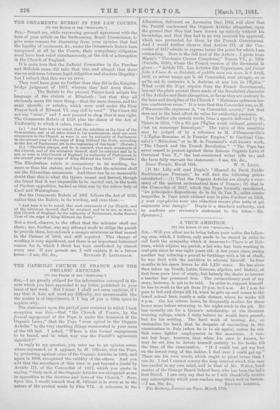THE ORNAMENTS RUBRIC IN THE LAW COURTS. [To THE EDITOR
OF THE " SPEOTATOR."]
Slit,—Permit me, while expressing general agreement with the tone of your article on the forthcoming Royal Commission, to give some reasons for dissenting • from your opinion that had the legality of vestments, &c., under the Ornaments Rubric been recognised at all by the Courts, their compulsory obligation must have been ruled simultaneously, at the risk of a disruption in the Church of England.
It is quite true that the Judicial Committee in the Purchas and Ridsdale cases- did take that line, and alleged that there was no mid-term between legal obligation and absolute illegality ; but I submit that this was an error.
They need have gone no further than they did in the Knights- br:clge judgment of 1857, wherein they laid down that,— The Rubric to the present Prayer-book adopts the language of the statute of Elizabeth ; but that they all obviously mean the same thing,--that the same dresses, and the same utensils, or articles, which were used under the First
Prayer-book of Edward VI, may still be used." The Court did not say " must?" and I now proceed to show that it was right.
The Ornaments Rubric of 1559, plus the clause of the Act of Uniformity to which it refers, runs thus :-
(a.) "And here is to be noted, that the minister at the time of the Communion, and at all other times in his ministration, shall use such ornaments in the Church as were in use by authority of Parliament in the second year of the reign of King Edward the Sixth, according to the Act of Parliament set in the beginning of this book." (Rubric.) (1).) " Provided always, and be it enacted, that such ornaments of the Church, and of the ministers thereof, shall be retained and be in use, as were in this Church of England, by authority of Parliament, in the second year of the reign of King Edward the Sixth." (Statute.) The Elizabethan rubric is compulsory in its wording, far more so than the statute, and lays down that the minister shall use the Edwardian ornaments. And there can be no reasonable doubt that this is what the Queen ' meant and desired, though she found that it was impossible to be carried out, in the teeth of Puritan opposition, backed as that was by the active help of Cecil and Walsingham.
But the Ornaments Rubric of 1661 follows the Act of 1559, rather than the Rubric, in its wording, and runs thus :-
" And here is to be noted, that such ornaments of the Church, and of the ministers thereof, shall be retained and be in use, as were in this Church of England, by the authority of Parliament, in the Second Year of the reign of King Edward the Sixth."
Not a word, observe, to the effect that the minister shall use them ; nor, further, was any attempt made to oblige the parish to provide them, beyond such a meagre minimum as that named in the Canons of 1603, and still required. This change of wording is very significant, and there is an important historical reason for it, which I think has been overlooked by almost
every one. If you permit me, I will explain it in a future


































 Previous page
Previous page